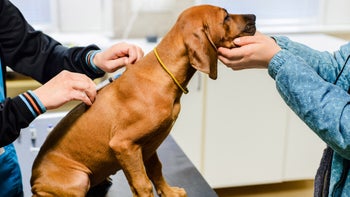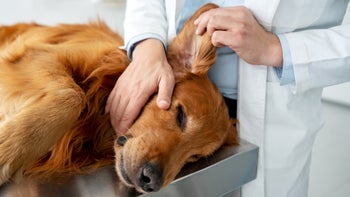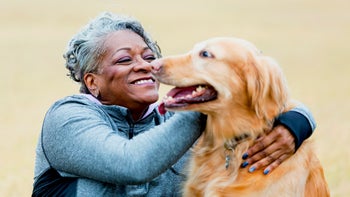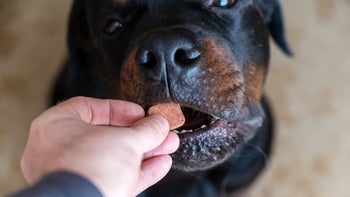
Dog Car Sickness: Causes and How to Stop Your Dog From Getting Motion Sickness
Key takeaways:
Motion sickness occurs when your dog’s sense of balance in their inner ear gets disrupted. This can happen wherever there is motion, like on a car or a plane.
You can prevent your dog from getting motion sickness by restricting food before car rides or using calming sprays.
If your pet continues to get motion sickness despite preventive measures, ask a veterinarian for other options, like medication.
Table of contents
Like humans, dogs can get sick and vomit wherever there is motion, such as during a car ride. Puppies are more prone to motion sickness than adult dogs. But no matter what age it happens, it’s not something a pet parent wants to see their dog experience.
You can’t completely get rid of motion sickness in dogs. But there are steps you can take to make this common problem less frequent.
What causes car sickness in dogs?
Motion sickness in dogs is caused by a physical or psychological issue. Motion sickness can happen anywhere there is motion. This includes cars, boats, planes, and trains.
Save on the top 10 pet medications
Save big on common pet medications like Fluoxetine and Levetiracetam at your local pharmacy.

GoodRx is NOT insurance. GoodRx Health information and resources are reviewed by our editorial staff with medical and healthcare policy and pricing experience. See our editorial policy for more detail. We also provide access to services offered by GoodRx and our partners when we think these services might be useful to our visitors. We may receive compensation when a user decides to leverage these services, but making them available does not influence the medical content our editorial staff provides.
When your dog’s motion sickness is caused by a psychological issue — such as car-related stress or anxiety — it can trigger the physical symptoms of motion sickness.
If your dog’s motion sickness is caused by a physical issue, it’s typically related to the inner ear.
Natalie Marks, DVM, said that the inner ear helps your dog with balance. When a dog is traveling in a car, this sense of balance can get disrupted because they see the scenery whizzing by even though they’re sitting still. As a result, the sensory organ in the inner ear signals the nausea and vomiting center in the brain.
Puppies are more susceptible to motion sickness because their inner ears have not fully developed, Marks said. But motion sickness can affect all dogs at any point in their lives.
So why do some dogs get motion sickness but others don’t?
“It’s really thought to be a combination of many factors, including genetics, previous negative experiences, inner ear differences, and any other changes that can cause auditory stress,” like ear infections, Marks said.
Do dogs sweat? No, they don’t. Read about how dogs cool themselves and what you can do if they seem overheated.
Can dogs get bird flu? Yes, they can. Here’s how to protect your dog from avian influenza.
Dementia in dogs: Selegiline is a medication that’s used to treat canine cognitive dysfunction. Learn more about selegiline.
What are the symptoms of motion sickness in dogs?
Motion sickness is easily noticeable when you pay attention to the symptoms. If you’re unsure if your dog gets car sick, here are some common symptoms of motion sickness:
Medications and tips to treat dog motion sickness
Motion sickness is not always preventable. But you can often limit it. And motion sickness can be treated safely using a few different methods.
Below are some remedies you can try.
1. Modify your car’s environment
During car rides, secure your dog in an approved seat belt with a harness. Bring along a familiar blanket or toy to help calm any anxiety.
Leave windows down for fresh air or to keep the car cool. Keeping the car quiet or playing only soft music (like classical music) can also help keep your pet calm.
2. Check your crate location
The location of your dog’s crate may help address car sickness. “Small dogs in crates should be placed on the floor of the middle seat — the location in the car with the least amount of motion,” Marks said.
A well-secured travel crate could also lessen sudden movements, Marks said.
A crate with solid sides will limit your dog’s field of vision. This could prevent them from getting sick. Keeping your dog from seeing out the side windows may also prevent them from getting sick.
3. Limit meals before travel
Avoid feeding your dog large meals before travel to limit vomiting. It’s recommended to withhold food for 8 hours before a long car, plane, or train ride. But keep your dog hydrated with plenty of water using spill-proof bottles or bowls.
4. Try desensitization training
If your dog is anxious or fearful of the vehicle, Marks recommended working with a trainer for “strategies on safe, slow, and positive desensitization.”
Start by sitting your dog in a stopped car. Offer a reward when they stay calm in the car. As your dog gets more practice, take short rides to places your dog will enjoy, such as the dog park.
5. Anti-nausea medications
Maropitant citrate (Cerenia), an FDA-approved medication, is often prescribed for motion sickness and vomiting in dogs. “It’s very safe and effective for puppies over 8 weeks of age,” Marks said.
You will need a prescription from a veterinarian for this medication. It’s typically given to dogs 2 hours before a car ride with food. It can cause extra salivation.
6. Antihistamine medications
Antihistamine medications may also help ease motion sickness in dogs. You can give over-the-counter medications such as:
Before giving human medication to dogs, talk with a veterinarian. They will help you find the right dosage.
Antihistamines like dramamine can be given to dogs 30 minutes before the car ride, and the effects can last 3 to 6 hours. Meclizine needs to be given 30 to 60 minutes before the car ride.
These medications can cause your dog to become drowsy and sleepy. They may also lead to dry mouth and the inability to urinate completely.
7. Anxiety medications
For dogs whose motion sickness is primarily caused by anxiety, a veterinarian may recommend an antianxiety medication. The best types for motion sickness are designed to be used in specific situations, like travel.
If a vet believes your dog could benefit from an antianxiety medication, they may prescribe options such as Xanax (alprazolam) or the antidepressant trazodone.
8. Sedative medications
Sedative medications may be another option for dogs with anxiety-related motion sickness. They help calm your dog. Common options include acepromazine or chlorpromazine, which require a prescription from a vet.
Acepromazine helps ease fear and anxiety, while chlorpromazine helps prevent vomiting. Both can make your dog sleepy for a long period of time, causing them to sleep throughout a car or plane ride.
Keep in mind that these medications may cause your dog’s urine to turn pink or reddish brown.
9. Ginger and other herbs
There is some evidence that ginger may help manage nausea and vomiting in dogs. But we don’t have a lot of research on how well it works or possible side effects.
Based on what we know, ginger will likely be most effective when given:
In tablet or capsule form
As a liquid supplement
As fresh root
Other herbs may also help dogs with symptoms of motion sickness. There is limited evidence, but these herbs may include:
Panax ginseng
Black horehound
Chamomile
Fringe tree
Meadowsweet
Lemon balm
Before giving your dog any natural herb or supplement, consult with their veterinarian. Dogs can overdose on natural products. Some can even be toxic to dogs or other animals in your house. And supplements may interact with other dog medications.
10. Natural calming products
Pheromone calming sprays and collars may help address motion sickness related to fear associated with car rides.
Pheromones are chemical compounds that dogs produce and use to communicate with one another, Marks said. Synthetic pheromones simulate this effect to help calm your pup. They come in sprays, collars, wipes, and plug-ins.
“These can be used in combination [with the above] to create a spa-like environment inside the car itself,” Marks added.
Marks recommended spraying the car using at least 8 to 10 pumps, 20 minutes before the ride, and repeating this routine every 4 hours for best results. Pheromones can also be sprayed within your dog’s carrier or crate.
When should you see a vet about your dog’s motion sickness?
If your dog gets sick often during car travel, ask a veterinarian about effective prevention and treatment. They can recommend medication options to try alongside preventive actions.
You should also call a vet if your dog is vomiting when they aren’t in a moving vehicle. Your dog could have vestibular disease. This is an inner ear disorder that needs diagnosis and treatment.
Signs of vestibular disease include:
Stumbling or staggering around
Motion sickness
Rotational or back-and-forth movement of the eyes
Head tilt
Frequently asked questions
Some dogs get car sick due to several factors, such as genetics, anxiety, inner ear disruptions, and other auditory stressors like ear infections. Others don’t get car sick because they don’t have contributing factors.
Yes, an older dog suddenly showing signs of car sickness is cause for concern. It may be a sign of vestibular disease or something more serious. Take your dog to a veterinarian to get them checked out.
There isn’t evidence suggesting that certain dog breeds are more prone to motion sickness than others. Puppies may be more susceptible because their inner ears aren’t fully developed. But any breed at any age can get car sick.
The bottom line
Any dog can get motion sickness. You can use preventive methods — such as properly securing your dog in the car with a harness or crate or desensitization training — to reduce motion sickness.
If preventive methods aren’t working, medication or supplements can help treat motion sickness. Ask a veterinarian about your dog’s options.
Why trust our experts?



References
American Veterinary Medical Association. (n.d.). Traveling with your pet FAQ.
Brooks, W. (2024). Meclizine hydrochloride (Bonine, Antivert, Dramamine, UniVert, Vertin-21). Veterinary Partner.
Calder, C. (2021). Car ride anxiety in dogs and cats. Veterinary Partner.
Newfield, A. (2016). Preventing motion sickness in dogs. Today’s Veterinary Nurse.
Today’s Veterinary Practice. (n.d.). Causes and treatment of motion sickness in a dog.
U.S. Food and Drug Administration. (2019). Cerenia- maropitant citrate tablet [package insert].

























